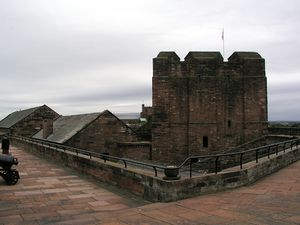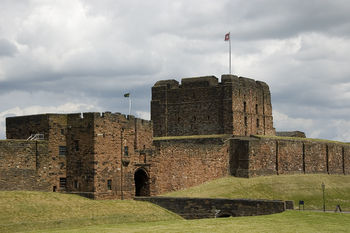Carlisle Castle
Carlisle Castle was founded by King William II of England in the 11th century near the Anglo-Scottish border. The castle's strategic position meant that from early in its history it saw military action, for the first time in 1135 when it was captured by King David I of Scotland. Carlisle Castle was particularly important during the Anglo-Scottish Wars of the the 13th and 14th centuries.
With over 900 years of use, the structures with together make up the castle date from various periods. The oldest standing part is the great tower (also commonly called a keep), which is the castle's tallest building and was constructed in the early 12th century. Now open to the public, with a museum detailing the castle's history, some parts of the complex are still used by the British Army.
History

The great tower was built in the 12th century on the orders of King Henry I of England.
In the 11th century the settlement of Carlisle lay in an area claimed by both England and Scotland. In 1092, King William II of England led a campaign in northern England to settle the claim. In the process of establishing the border between the two countries, William established a number of castles including one at Carlisle. So little is known about this first castle that even its location and design are sources of speculation; however, it was mostly likely built at the north of the settlement (where the current castle now stands) and consisted of an earthen banks with a wooden palisade, surrounding timber buildings. In 1122, King Henry I of England visited Carlisle Castle, and ordered the enhancements of the castle's defences. This included building a great tower – the sort which became emblematic of castles built in the 12th century. The tower still stands today.[1]
On the death of Henry I, there was a dynastic struggle between the supporters of his daughter (the Empress Matilda) and his nephew (King Stephen). King David I of Scotland supported Matilda and in 1135 captured Carlisle Castle. He used the conflict to extend his territory into northern England. The Scots controlled Carlisle Castle until 1157 when the new English King, Henry II, forced them out of Carlisle. Shortly afterwards, Henry II took the opportunity to improve the castle's defences.[2]
Layout and architecture
Carlisle Castle sits at the northern end of the settlement after which it is named, with its main entrance situated in the south wall, looking through the centre of town. The castle is an irregular shape, the oldest parts of which date to the 12th century. The outer walls which mark the extent of Carlisle Castle date from this period. A stone wall divides the castle into two parts known as 'baileys'. The outer bailey, through which all visitors would pass, was remodelled in the 19th century and contains modern military buildings. The inner bailey, occupying the eastern tip of the castle, is the medieval core of Carlisle Castle, with a large 12th-century great tower, but like the outer bailey it too has modern buildings, in this case acting as storerooms and housing the Regimental museum. In the easternmost corner of the inner bailey used to stand Queen Mary's Tower; it was built in 1308 and is named after Mary, Queen of Scots, who was imprisoned at Carlisle Castle.[3]
Though Carlisle Castle was built over part of a Roman fort, the remains do not seem to have strongly influence the layout of the castle.[4] This contrasts with castles such as Portchester or Pevensey where the medieval structures were inserted into Roman forts, exploiting substantial stone remains.
References
- ↑ Summerson, Henry (2008). Carlisle Castle. London: English Heritage. pp. 23–24. ISBN 978-1-84802-011-5.
- ↑ Summerson, Carlisle Castle, p. 24.
- ↑ Summerson, Carlisle Castle, p. 41.
- ↑ Summerson, Carlisle Castle, p. 23.
